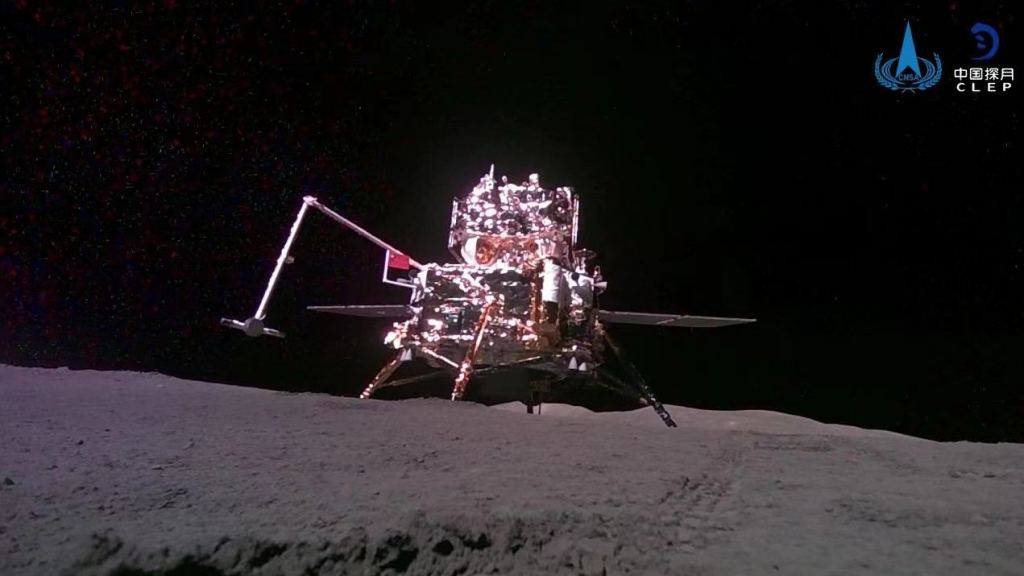The newest phase of China's lunar exploration project is soon coming to an end. On June 20th, the Chang'e 6 sample return mission starts its journey back to Earth from the far side of the Moon, having already collected samples and blasted itself back into lunar orbit. But since a picture is worth a thousand words, let's look at some of the more memorable images that have come out of this mission so far.
China's National Space Agency (CNSA) released up close and personal images of the Chang'e-6 landers/ascender system on June 14th. They were taken by a small, autonomous rover that descended from the lander, maneuvered to a suitable position, framed a photograph, and took one, all without input from its human overlords.
Weighing in at only 5 kg, the rover showed what is possible for autonomous operation with relatively light hardware. It also shows an impressive amount of autonomy for a lunar rover, especially one operational only on the "far" side of the Moon.
It wasn't the only observer that captured an interesting image of China's sixth mission in a series named after Chang'e, the Chinese Moon goddess. NASA's Lunar Reconnaissance Orbiter captured the orbiter from overhead space and showed a dramatic change in its surroundings.
In the image, the lander itself appears as a bright white dot. However, the surrounding area also appears significantly lighter. This had to do with the blast radius of the lander's retrograde rockets for its soft landing. Those powerful rockets blew away the dark lunar regolith that had remained untouched for millions of years. The picture was snapped on June 7th, after the Chang'e-6 ascent vehicle had launched back off the surface and rendezvoused with the orbiter that will take the samples it collected back to Earth. In so doing, it likely blew away plenty of material with its own ascent rockets.
During its time on the Moon, Chang'e-6 collected 2 kg of samples, which it will return to a laboratory on Earth. This is the second time CNSA has planned such a mission and the first time one has taken place on the far side that humans cannot see from Earth.
Fraser discusses the Chang'e-6 mission to collect lunar samples in this news update.The next in the sequence of Chinese moon missions is Chang'e-7, which will focus its research efforts on the lunar south pole. Scientists predict water ice might be abundant there and that it might be the potential future site of a crewed Chinese moon base. Chang'e-7 will also include a hopping rover to explore the local environs surrounding its lander, but it isn't scheduled for launch until 2026.
Currently, the Chang'e-6 mission orbiter, which has already successfully docked with the ascent vehicle containing the collected samples, is waiting for the opportune time to return to Earth. It will also serve as the return vehicle, which is planned to land back on Earth on June 25th. If all goes according to plan, there will soon be more lunar samples for scientists to explore and another successful mission for the CSNA that will have been documented in some pretty astounding pictures.
Learn More:
CGTN - Unraveling Chang'e-6: Discover the mini rover that snapped a photo of Chang'e-6 probe
NASA - NASA’s LRO Spots China’s Chang’e 6 Spacecraft on Lunar Far Side
UT - Chinese Probe Collects Moon Samples and Heads for Earth
UT - Chinese Probe Lands on Moon’s Far Side to Collect Samples for Return
Lead Image:
This image from NASA's Lunar Reconnaissance Orbiter shows China's Chang'e 6 lander in the Apollo basin on the far side of the Moon on June 7, 2024. The lander is the bright dot in the center of the image. The image is about 0.4 miles wide (650 meters); lunar north is up.
Credit: NASA/Goddard/Arizona State University
 Universe Today
Universe Today

